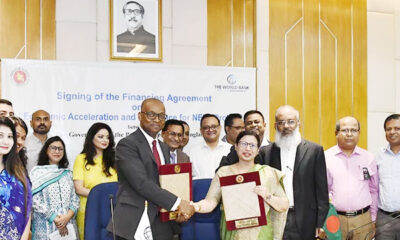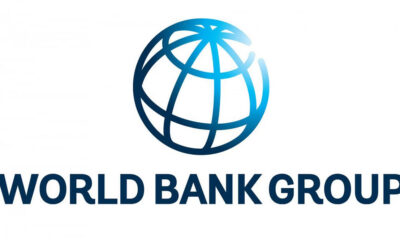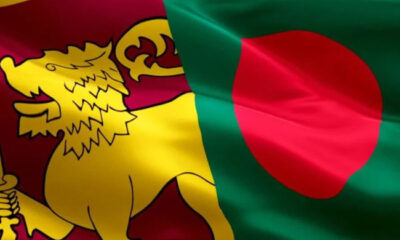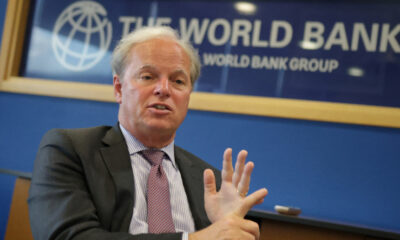Bangladesh
Bangladesh at 50: From ‘basket case’ to rising economic star
Published
4 years agoon

As Bangladesh marks the 50th anniversary of its victory, experts note that it has transformed itself from an economic “basket case” into one of the world’s fastest-growing economies.
When Pakistani forces laid down arms in Bangladesh’s bloody liberation war, the newly-independent South Asian nation’s economy was in tatters. Over 80 per cent of the population were living in extreme poverty.
In the following years, the country struggled with military coups, political turmoil, poverty and famine. Now, as Bangladesh country celebrates its 50th Victory Day, the situation appears to have dramatically changed for the better.
The holiday commemorates the victory of the Bangladesh forces over Pakistani forces in the Bangladesh Liberation War on December 16, 1971.
In the 1970s, it was argued that “if development is possible in Bangladesh, it is possible in any other country,” Mustafizur Rahman, an economist at Bangladesh’s Center for Policy Dialogue, told DW.
He added that the South Asian country was viewed as “the test case” of development.
Norwegian social researcher Eirik G. Jansen said, however, that when he returned to a Bangladeshi village in 2009 after a gap of nearly three and a half decades, he was surprised to see the remarkable improvement in socioeconomic development and people’s income levels.
“Their incomes increased tenfold. It meant they could buy at least 10-15 kilograms of rice with their daily wages,” Jansen told DW.
“If you have five or six people in your household and you come home with just one and a half kilograms of rice, you can hardly feed the entire family,” Jansen said.
“Severe poverty meant many people lacked enough food. Health and education services hardly existed. Many people became sick, and many died in their 40s and 50s due to diseases that could have been prevented if they had good nutrition. Many children also died,” the expert added.
Making strides in growth and development
Before the onset of the coronavirus pandemic, the economy was growing rapidly, recording an annual expansion in the range of 8 per cent for years.
The Asian Development Bank said that despite the hit from the pandemic, the Bangladeshi economy is recovering fast.
“Bangladesh also grows enough food now to feed its 167 million people. The country has a significantly reduced maternal and infant mortality rate than many other countries in the world,” Rahman said.
Bangladesh achieved lower middle-income country status in 2015 and is on track to leave the United Nations’ Least Developed Countries list.
Currently, 98 per cent of children nationwide have finished primary school, with more girls in secondary school than boys.
Observers say the Muslim-majority nation over the years has invested heavily in the lives of women and girls. It has also made progress in combating child malnutrition and reproductive health.
Jansen said when he visited the village in Manikanj again in 2010, he found that schools in the area were refurbished, and both boys and girls were going to school.
The improvement in female education has transformed the socioeconomic structure, he pointed out.
“Providing scholarships for women’s and girls’ education is another factor. The women are now more articulate. They are not as shy as when I saw them four decades earlier.”
From agriculture to industry
With a GDP of over $409 billion (€362 billion), Bangladesh currently has the world’s 37th largest economy and forecasts suggest that the size of the economy could double by 2030.
While it was primarily an agricultural economy in 1971, the composition has changed over the decades, with industry and services now accounting for the lion’s share of economic output. Agriculture’s share of GDP has dropped to just 13 per cent.
It was the availability of job opportunities outside agriculture that drove economic development, said Jansen.
“For many women, it was working in the textile industry and handicrafts. For men, it was jobs in local small industries. For some, it was migrating abroad to the Middle East, Singapore or Malaysia.”
The garment industry emerged as one of the nation’s success stories in recent decades. It is the second-largest globally, only surpassed by China, and rakes in over $35 billion a year from exports.
The sector employs 4 million people, the majority of whom are women, contributing to female empowerment.
“The garment sector has changed not only the economy, but also women’s social status in Bangladesh,” Rahman said. Meanwhile, the Bangladesh government has set an overall target for exports amounting to $51 billion in 2022.
Remittances also play a major role in the economy, with Bangladeshi workers employed abroad transferring nearly $24.7 billion in the fiscal year 2021.
Quality and inequality challenges
Despite the steep rise in the number of children going to school, the quality of education remains poor, posing a major challenge to the development of a skilled workforce, said Rahman.
Also, not everyone has benefited equally from the nation’s impressive growth and development, say experts, pointing to rising income and wealth inequality, as well as the slow pace of job creation.
“Per capita income has increased in Bangladesh. But income and wealth distribution could be made equal and fair,” Rahman said. “The income disparity between the top 5 per cent and the bottom 40 per cent is increasing day by day.”
Another problem is the heavy concentration of economic activity in big cities like Dhaka and Chittagong, resulting in a huge rural-urban divide and increased urban poverty.
“The poverty level might have come down to 20 per cent, but 50 per cent of those living in some cities face poverty,” Rahman stressed.
As it marks Victory Day, the biggest challenge Bangladesh faces is related to how the country ensures that the fruits of growth and development reach people at the bottom of the economic pyramid
You may like
-


World Bank Helps 900,000 Rural Youth in Bangladesh with Better Employability and Entrepreneurial Opportunities
-


Bangladesh Receives $858 Million World Bank Financing to Improve Climate Resilient Agriculture Growth and Road Safety
-


Sri Lanka pays back $50 million to Bangladesh
-


UK: Bangladesh makes huge progress in last 20 years
-


ASUS launched four incredible laptops in Bangladesh
-


World Bank Managing Director to Visit Bangladesh
Bangladesh
Bangladesh’s Press at a Crossroads: Between Promises of Reform and the Shadows of Repression
Published
4 months agoon
August 14, 2025
By Md Mojahidul Islam Dheow
Bangladesh’s press is at a crossroads. A year after the mass uprising of 2024 promised a fresh dawn for the country’s long-troubled media, journalists still move under a heavy cloud of political, institutional, and psychological pressure. Across the nation, more than 250 cases have been filed against reporters in the last 12 months—not all for crimes of substance. Some are clear attempts to stifle critical reporting; others stem from something as ordinary as a social media post. The message is unmistakable: those who challenge authority face serious consequences.
Legal reform has offered a glimmer of hope with the newly debated Section 173A of the CrPC, 1898, which allows an accused to be discharged during investigation if a high-ranking police supervisor finds insufficient evidence. But the question remains: will this tool be used impartially—or selectively, to shield the powerful and punish dissenters?
The dangers facing journalists were made starkly clear on August 7, when Asaduzzaman Tuhin was killed while on duty. Just a day earlier, Anwar Hossain was assaulted while reporting on extortion at a Gazipur CNG auto-rickshaw stand. These incidents are not isolated—they are part of a pattern of violence and intimidation aimed at silencing the press.
Even the newly crafted Cyber Security Ordinance (CSO) 2025—intended to replace repressive predecessors like the Digital Security Act (DSA) 2018 and the Cyber Security Act (CSA) 2023—retains troubling elements. While some contentious sections have been removed, Section 42 still allows the use of repressive tools drawn from the ICT Act 2006, the Evidence Act 1872, and the CrPC. Vague phrases such as “public confusion,” “threats to national security,” and “anti-state acts” remain undefined, enabling broad crackdowns on civil liberties, journalism, and political opposition.
Beyond the legal framework lies a deeper crisis. Corporate influence and editorial compromises have long weakened investigative journalism in Bangladesh. The media’s role as a pillar of democratic accountability has eroded, with many outlets beholden to owners’ political and commercial interests. With no substantial institutional reform since the change in government, the press remains vulnerable to regulatory harassment, licensing obstacles, and punitive taxation whenever coverage strays from the “approved” line.
Two proposed reform measures—the Journalists’ Protection Ordinance 2025 and the National Media Commission Ordinance 2025—once promising, are stalled in bureaucratic limbo. The “one house, one media” policy, intended to prevent individuals or organizations from owning multiple outlets, remains unrealized despite the Media Reform Commission’s advocacy.
Even the Bangladesh Press Council risks becoming yet another instrument of state control unless its mandate is reimagined to prioritize journalist protections. Political divisions within journalist unions and media organizations further weaken any unified stance for press freedom. Ownership patterns skew licensing and content toward vested interests, while dissenting voices are punished through regulatory harassment or punitive audits. Inside newsrooms, self-censorship grows as fear of legal trouble and professional retaliation suppresses candid reporting. Whistleblowers remain silent, and investigative journalism is increasingly replaced by risk-averse coverage.
What Bangladesh needs is a national framework for self-regulation that binds all outlets: an internal editorial code of conduct, a grievance redressal mechanism, anti-harassment policies, and straightforward complaint resolution processes. A transparent, independent media ombudsman should adjudicate defamation claims and public complaints. Only with genuine independence, accountability, and a clear commitment to journalist safety can the industry rebuild trust and integrity.
Beyond reform, there is an urgent need for immediate protection and practical empowerment of reporters in the field. The proposed Journalists’ Rights Protection Ordinance 2025 aims to codify such protections, with penalties of up to five years’ imprisonment and substantial fines for violence against journalists. It would:
(a) defend journalists from violence, threats, and harassment;
(b) shield sources and protect newsroom independence;
(c) guarantee the right to work without fear;
(d) ensure safe reporting environments within media organizations;
(e) safeguard good-faith reporting; and
(f) establish clear complaint, investigation, and trial procedures.
The ordinance mandates that fines can be directed as compensation to the harmed journalist and holds both individuals and, when applicable, organizations accountable for failing to prevent or address abuses.
If implemented effectively, it could mark a turning point. But enforcement requires a judiciary capable of handling cases efficiently and free from political influence. Authorities must be bound by law to protect journalists, safeguard newsroom neutrality, and defend those who publish information in the public interest.
The current moment is pivotal. Real reform demands more than laws on paper—it requires political courage, institutional independence, and a mature democratic culture. Journalists must unite beyond political divides, media owners must shed partisan agendas, and the state must commit to protecting the very people who hold it accountable.
Time is slipping away. Each delay erodes public trust, silences more journalists, and buries more truths. If Bangladesh is to have a democracy worthy of the name, it must build a press that is free, secure, and independent—not as an ornament of democracy, but as its beating heart.
Bangladesh
Investigation: Hasina’s ‘Shoot Directly’ Order and Its Deadly Consequences
Published
4 months agoon
July 25, 2025
On the morning of July 27, 2024, Sheikh Hasina stood silently at the podium of the National Institute of Traumatology and Orthopedic Rehabilitation (NITOR), commonly known as Pongu Hospital, in Dhaka.
For nearly 14 seconds during her eight-minute emotional speech, the former prime minister remained silent. A visible pain marked her face, reflecting the weight of the bloodshed that had occurred since July 16, when police forces fatally shot Abu Sayed in Rangpur with lethal weapons. That day, five more lives were lost amidst violence in Dhaka and Chattogram.
By the time Hasina addressed the crowd at NITOR, the death toll across the last two weeks had reached at least 162, many of whom had been shot with military-grade weapons by state security forces, according to The Daily Star’s investigations.
“I seek justice from my fellow citizens. What crimes have I committed to deserve this?” 77-year-old Hasina asked after visiting some of the injured at the hospital.
“I don’t want any mothers to lose their children like this. I’ve lost my parents; I know the pain… So many lives have been lost, so many families shattered. Who is responsible for all this?…” she began, but then, overcome with emotion, she left the stage in tears, unable to finish her words.
This heartfelt public address sharply contrasts with what was happening behind the scenes. An investigation by The Daily Star reveals that a state-sponsored machinery for mass violence had already been put into motion.
Just nine days earlier, on the evening of July 18, 2024, a phone rang inside the ousted prime minister’s residence, Gonobhaban, and Sheikh Hasina answered. On the line was Sheikh Fazle Noor Taposh, then the mayor of Dhaka South City. What followed was a startling disclosure of a lethal plan.
“We are now doing things differently. We are capturing photos with drones, and sending helicopters to several places,” Hasina told Taposh.
“Wherever they [the state forces] see gatherings, from the sky… I am getting it done from above, already started in several areas… already underway,” she said, while Taposh repeatedly pressed for launching a large-scale arrest campaign.
Bangladesh
WB to provide $250m loan to modernise five public sector functions
Published
6 months agoon
June 15, 2025
The World Bank (WB) would provide US$250 million funds to facilitate improving transparency, accountability, and efficiency of some key government agencies in Bangladesh.
FE
The WB board on Saturday approved the loan to support the ongoing reform initiatives of the interim government, aimed at modernising crucial public sector functions.
These are essential for improving data transparency, domestic revenue mobilisation, public investment management, public procurement, and financial oversight, according to a statement issued on Saturday.
Under the Strengthening Institutions for Transparency and Accountability (SITA) project, five key government agencies – the Bangladesh Bureau of Statistics (BBS), the National Board of Revenue (NBR), the Planning Division, the Bangladesh Public Procurement Authority (BPPA), and the Office of the Comptroller and Auditor General (CAG) – would reform their operational activities.
The project is expected to streamline operations and improve service delivery within the five agencies and enhance access to reliable public statistics, crucial for transparent and accountable decision-making and policy formulation.
It will help modernise tax administration and increase tax compliance, thereby improving much-needed revenue mobilisation and fiscal sustainability.
The WB loan will also help improve the efficiency and accountability of public spending, ensuring that resources are utilised effectively for the benefit of all citizens.
It will develop a second generation of electronic government procurement (e-GP) and broaden its scope. The project will also help strengthen and digitise public audit.
Gayle Martin, the World Bank’s Interim Country Director for Bangladesh, on Saturday said: “The investment will leverage digitisation of business processes to help improve transparency and reduce corruption, by supporting Bangladesh in modernising public institutions capable of serving an emerging economy.”
This project will help improve the quality and accessibility of public services and thus enhance public trust in government institutions, she added.
According to the statement, the Bangladesh government and the WB are also preparing a development policy credit scheduled for the bank’s board discussion later this month.
Such credit is expected to support transparency and accountability in domestic revenue mobilisation, the banking sector, data production and dissemination.
Souleymane Coulibaly, World Bank Lead Country Economist and Task Team Leader for the project, said: “This project and the proposed development policy credit would be complementary and provide the government both the necessary hardware and software for improving public financial management and public service delivery.”

From Confusion to Clarity: Dheow’s Book Helps Users Master ChatGPT Conversations

Pre-Orders Open for Mojahidul Islam’s Latest Computer Book ‘AI Shikhun, Taka Gunun’

Bangladesh’s Press at a Crossroads: Between Promises of Reform and the Shadows of Repression










